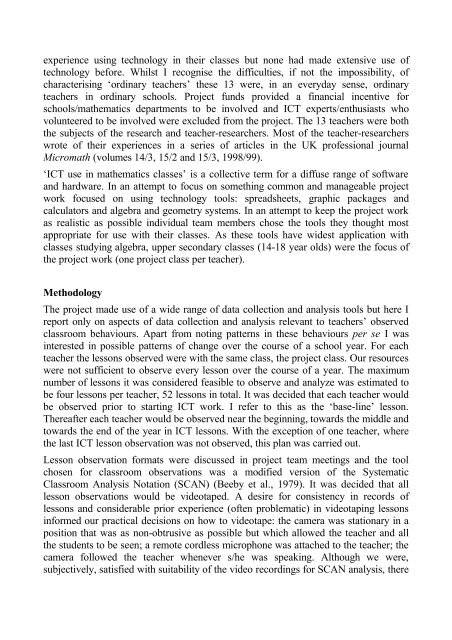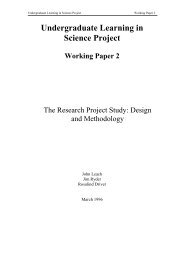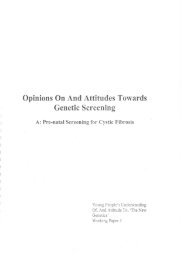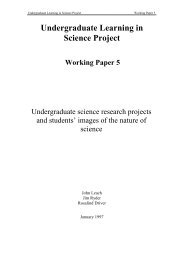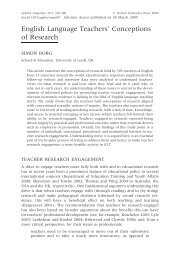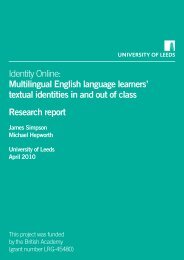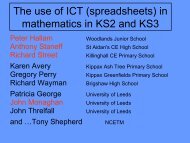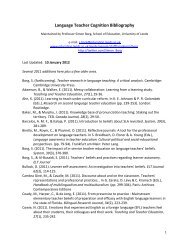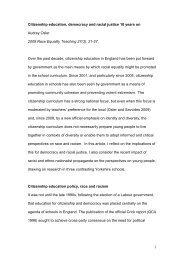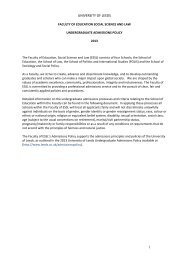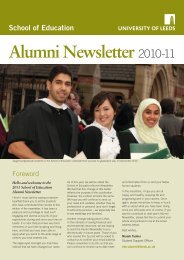Teachers' Classroom Interactions in ICT-based Mathematics Lessons
Teachers' Classroom Interactions in ICT-based Mathematics Lessons
Teachers' Classroom Interactions in ICT-based Mathematics Lessons
You also want an ePaper? Increase the reach of your titles
YUMPU automatically turns print PDFs into web optimized ePapers that Google loves.
experience us<strong>in</strong>g technology <strong>in</strong> their classes but none had made extensive use oftechnology before. Whilst I recognise the difficulties, if not the impossibility, ofcharacteris<strong>in</strong>g ‘ord<strong>in</strong>ary teachers’ these 13 were, <strong>in</strong> an everyday sense, ord<strong>in</strong>aryteachers <strong>in</strong> ord<strong>in</strong>ary schools. Project funds provided a f<strong>in</strong>ancial <strong>in</strong>centive forschools/mathematics departments to be <strong>in</strong>volved and <strong>ICT</strong> experts/enthusiasts whovolunteered to be <strong>in</strong>volved were excluded from the project. The 13 teachers were boththe subjects of the research and teacher-researchers. Most of the teacher-researcherswrote of their experiences <strong>in</strong> a series of articles <strong>in</strong> the UK professional journalMicromath (volumes 14/3, 15/2 and 15/3, 1998/99).‘<strong>ICT</strong> use <strong>in</strong> mathematics classes’ is a collective term for a diffuse range of softwareand hardware. In an attempt to focus on someth<strong>in</strong>g common and manageable projectwork focused on us<strong>in</strong>g technology tools: spreadsheets, graphic packages andcalculators and algebra and geometry systems. In an attempt to keep the project workas realistic as possible <strong>in</strong>dividual team members chose the tools they thought mostappropriate for use with their classes. As these tools have widest application withclasses study<strong>in</strong>g algebra, upper secondary classes (14-18 year olds) were the focus ofthe project work (one project class per teacher).MethodologyThe project made use of a wide range of data collection and analysis tools but here Ireport only on aspects of data collection and analysis relevant to teachers’ observedclassroom behaviours. Apart from not<strong>in</strong>g patterns <strong>in</strong> these behaviours per se I was<strong>in</strong>terested <strong>in</strong> possible patterns of change over the course of a school year. For eachteacher the lessons observed were with the same class, the project class. Our resourceswere not sufficient to observe every lesson over the course of a year. The maximumnumber of lessons it was considered feasible to observe and analyze was estimated tobe four lessons per teacher, 52 lessons <strong>in</strong> total. It was decided that each teacher wouldbe observed prior to start<strong>in</strong>g <strong>ICT</strong> work. I refer to this as the ‘base-l<strong>in</strong>e’ lesson.Thereafter each teacher would be observed near the beg<strong>in</strong>n<strong>in</strong>g, towards the middle andtowards the end of the year <strong>in</strong> <strong>ICT</strong> lessons. With the exception of one teacher, wherethe last <strong>ICT</strong> lesson observation was not observed, this plan was carried out.Lesson observation formats were discussed <strong>in</strong> project team meet<strong>in</strong>gs and the toolchosen for classroom observations was a modified version of the Systematic<strong>Classroom</strong> Analysis Notation (SCAN) (Beeby et al., 1979). It was decided that alllesson observations would be videotaped. A desire for consistency <strong>in</strong> records oflessons and considerable prior experience (often problematic) <strong>in</strong> videotap<strong>in</strong>g lessons<strong>in</strong>formed our practical decisions on how to videotape: the camera was stationary <strong>in</strong> aposition that was as non-obtrusive as possible but which allowed the teacher and allthe students to be seen; a remote cordless microphone was attached to the teacher; thecamera followed the teacher whenever s/he was speak<strong>in</strong>g. Although we were,subjectively, satisfied with suitability of the video record<strong>in</strong>gs for SCAN analysis, there


